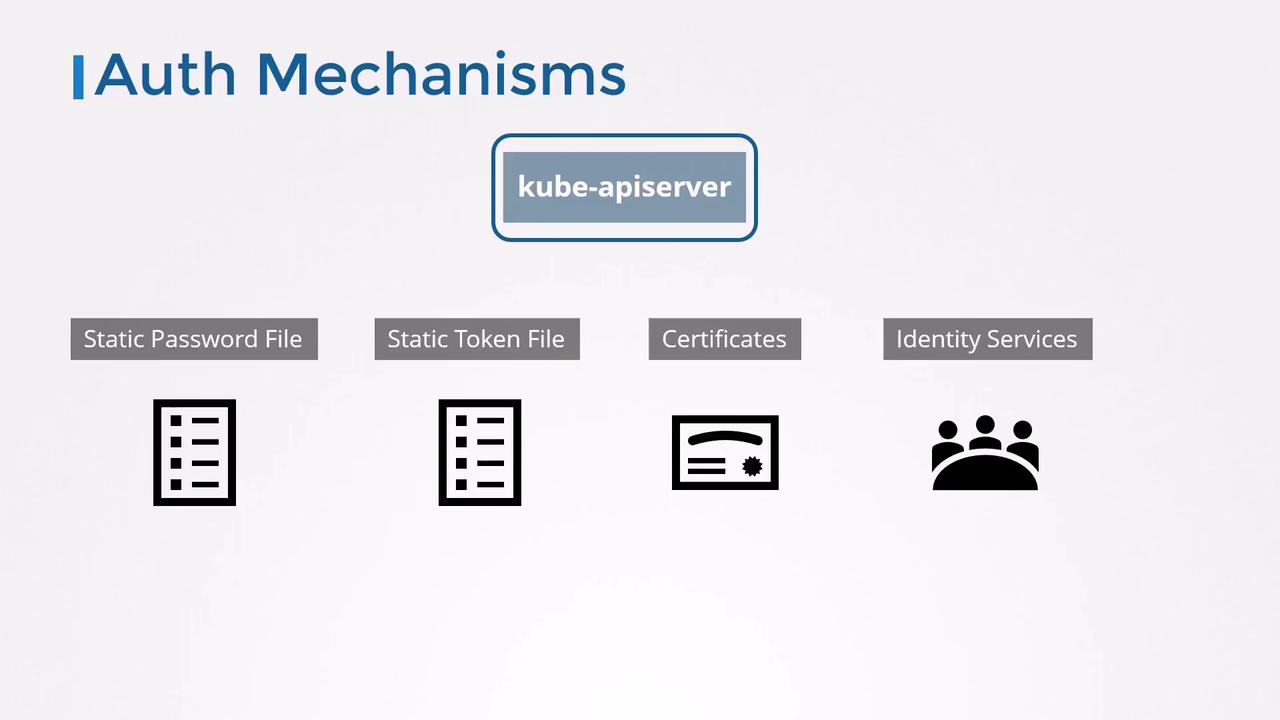Kubernetes and Cloud Native Security Associate (KCSA)
Kubernetes Security Fundamentals
Authentication
Welcome to this lesson on authenticating access to a Kubernetes cluster. A cluster consists of multiple physical or virtual nodes and several internal components working together to run your workloads. It’s crucial to secure management access by verifying identities for anyone or anything interacting with the API server.
Actors interacting with the cluster:
| Actor | Description | Examples |
|---|---|---|
| Administrators | Manage infrastructure and policies | Cluster operators, DevOps engineers |
| Developers | Deploy and maintain applications | CI/CD engineers, application owners |
| Robotic Clients | Automated systems accessing the API server | Monitoring tools, pipelines |
Kubernetes relies on external identity sources (files, certificates, identity services like LDAP or OIDC) for human user authentication, while it internally manages service accounts. All requests pass through the kube-apiserver, which authenticates before authorizing.
Supported authentication methods:
| Method | Description |
|---|---|
| Static Password File | CSV listing username, password, UID, [optional groups] |
| Static Token File | CSV listing bearer token, username, UID, [optional groups] |
| Client Certificates | X.509 certificates for users |
| External Identity Service | LDAP, OIDC, webhook token authentication |

1. Static Password File
The simplest approach uses a CSV file with one line per user:
password123,user1,u0001,group1
password123,user2,u0002,group1
password123,user3,u0003,group2
password123,user4,u0004,group2
password123,user5,u0005,group2
Configuring the API Server
Choose your setup:
Systemd unit (
/etc/systemd/system/kube-apiserver.service):ExecStart=/usr/local/bin/kube-apiserver \ --advertise-address=${INTERNAL_IP} \ --allow-privileged=true \ --authorization-mode=Node,RBAC \ --bind-address=0.0.0.0 \ --etcd-servers=https://127.0.0.1:2379 \ --service-cluster-ip-range=10.32.0.0/24 \ --service-node-port-range=30000-32767 \ --runtime-config=api/all \ --enable-swagger-ui=true \ --event-ttl=1h \ --v=2 \ --basic-auth-file=/path/to/user-details.csvkubeadm (edit
/etc/kubernetes/manifests/kube-apiserver.yamlunderspec.containers.command):apiVersion: v1 kind: Pod metadata: name: kube-apiserver namespace: kube-system spec: containers: - name: kube-apiserver image: k8s.gcr.io/kube-apiserver-amd64:v1.11.3 command: - kube-apiserver - --authorization-mode=Node,RBAC - --allow-privileged=true - --advertise-address=172.17.0.107 - --etcd-servers=https://127.0.0.1:2379 - --service-cluster-ip-range=10.32.0.0/24 - --service-node-port-range=30000-32767 - --runtime-config=api/all - --enable-bootstrap-token-auth=true - --enable-swagger-ui=true - --event-ttl=1h - --v=2 - --basic-auth-file=/path/to/user-details.csv
After saving changes, the API server will restart automatically (kubeadm) or after reloading your systemd unit.
Testing Password Authentication
curl -u user1:password123 https://<api-server-ip>:6443/api/v1/nodes
2. Static Token File
Bearer tokens offer another static method. Create a CSV containing tokens:
KpjCVbI7cCEAHYPkByTizRb7gulcUc4B,user0,u0010,group1
rJjncHmvtXHc6MlWQddhtvNyyhgTdxSC,user1,u0011,group1
mjoOFTEiFOKL9toikaRNtt59ePtczZSq,user2,u0012,group2
PG41IXhs7QjqWkmBkvG9gICloYuQzI,user3,u0013,group2
Add to your API server flags:
--token-auth-file=/path/to/user-token-details.csv
Testing Token Authentication
curl -H "Authorization: Bearer KpjCVbI7cCEAHYPkByTizRb7gulcUc4B" \
https://<api-server-ip>:6443/api/v1/namespaces
Warning
Storing usernames, passwords, or tokens in plain text is not recommended for production. Use secure vaults or external identity providers for sensitive environments.

Security Considerations
- For kubeadm clusters, mount your credential files into the API server Pod via a volume.
- Protect files with restrictive filesystem permissions (
chmod 600). - After authenticating users, configure Role-Based Access Control (RBAC) to grant least-privilege permissions.
Next, we’ll explore certificate-based authentication and how Kubernetes components use TLS certificates to secure communication.
Watch Video
Watch video content